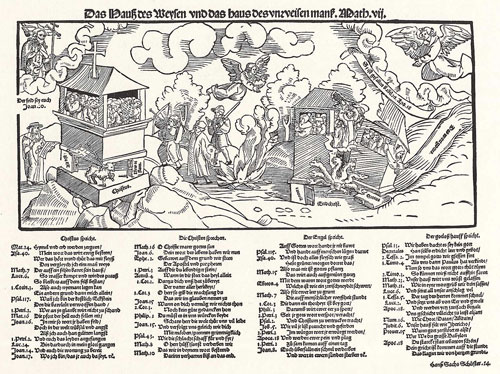The House of the Wise Man and the House of the Foolish Man

Based on a parable of Jesus from the Sermon on the Mount (Matthew 7:24–7:27), this handbill portrays the fate of two houses: the house of the "wise man", built on the rock of "Christ" (symbolized by the lamb) and the pillars of the Old and New Testament, in which there is a group of middle-class adherents to the Reformation who are turned towards Christ; and the house of the "foolish man", built on the sand of the Endchrist (symbolized by the seven-headed beast from the book of Revelation 17:3,7) and the pillars of canonical law and the theology of John Duns Scotus. This house is filled predominantly with clerics and monastics. While the first house stands strong despite the attacks of a monk (farmer?) and a theologian, the second house is breaking apart, undermined by the river of the Word of God. The risen Christ along with two angels is pronouncing the fate of the foolish man from heaven.
Erhard Schön (1491–1542), Das Hauß des Weysen und das haus des unweisen manß, Math.vij., handbill with woodcut & letterpress, 28.8 cm x 37.5 cm, Nuremberg, 1524, text by Hans Sachs (1494–1576) (Works, vol. 25, Reg. No. 526), Geisberg/Strauss No. 1139; source: Bildagentur für Kunst, Kultur und Geschichte, bpk-bildagentur.de/, © bpk/Staatsbibliothek zu Berlin – Preußischer Kulturbesitz.